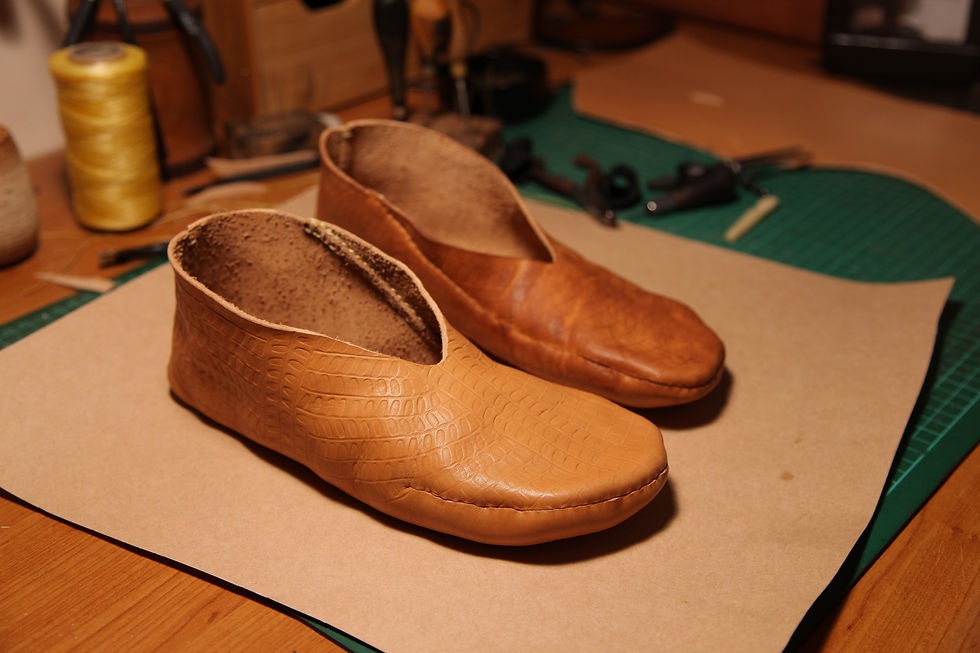A Pictish shoe replica
- Hamish Lamley
- Jun 29, 2018
- 3 min read
Updated: May 23, 2020

The first replica pair of shoes.
When it comes to the Picts, they really did not leave much behind for us to remember them by. There are mysterious stones spread across the land, and the odd archaeological find here and there, and even less in literature form. As a craftsman, I am always looking for tidbits of ancient craft to connect with, so it can be frustrating when we have so little to go by. And so I was astounded when I happened across an excavation report undertaken at Dundurn Hillfort in central Scotland, where an entire preserved shoe was found! Since the original report was written in the 80s, next to nothing has been published about the find, and there were only a handful of old images to go by. It immediately grabbed my interest, or my obsession with Pictish artefacts and I knew I had to recreate this shoe. Thus began my journey of walking in Pictish footsteps...

Dundurn Hill as it stands today.
So a little about the Hillfort to begin; it lies in St Fillans, directly to the east of Loch Earn. It's a rocky knoll commanding views all around, and in it's time was a nuclear hillfort with defences build around the entire hill making it incredibly formidable. Excavations have identified three stages of fortification between 500 and 800 AD. The fort at Dundurn (or Dún Duirn) is mentioned twice in the Annals of Ulster, firstly relating to a siege in 683 AD, at which time it was held by King Bridei III, and secondly as the location of the death of a king in 889 AD, and to have been a principal Pictish stronghold; certainly the eastern equivalent of Dunadd. It is believed to have been the Western frontier of the Southern Picts.

Dundurn may have looked something like this drawing by Peter Dennis. The shoe itself was incredibly well preserved, and now resides at the Hunterian Museum in Glasgow. I was allowed access to examine the shoe in full detail in order to produce the replica. The original is only approx 18cm long, and whilst very small it has most likely shrunk a little from being in the ground so it may have been slightly larger. Did it belong to a woman with small feet, or an adolescent male? We can only guess. No detailed analysis has been made of the leather itself, so we do not know if it is cowhide or deerhide.

Examining the original shoe.
What makes the Dundurn shoe completely unique is the patterned decoration covering the shoe, and the construction of the shoe is over-engineered compared to other contemporary shoes. It appears to be one-piece construction, with the front seam brought up and away from the ground which is a very technical method of construction. We see a similar style of shoe in Ireland, but none with the same sort of decoration. The craft and artistry that went in to this shoe is astounding, and truly showcases the skill of the original craftsman. During the research and construction of the replica shoe, I was fortunate to have a student, Ryan Bain, who wanted to film the whole process. Here is the fantastic film he put together.
Now that I have created a replica, I will wear them throughout the year in all terrains to give them a good test to see how they hold up. Walking in the footsteps of the Picts should give us a deeper insight into their life, so that we may better understand and honour our ancestors.
Thank you for reading, and huge thanks to everyone who was involved in the process from the museum staff, to Ryan & John for filming, Ian for being in the film with me, and Kjell for his music.

The first replica i made in the making before waxing. I have since made around a dozen pairs, and even a small to scale replica for a local archaeology display. Each time I make a new pair I discover another wee secret in the making.


Taking my replica shoes up Dundurn hill. I have had to add a lace to keep the shoes tight for tough terrain, leaving me to believe the original shoe was for light walking only.








